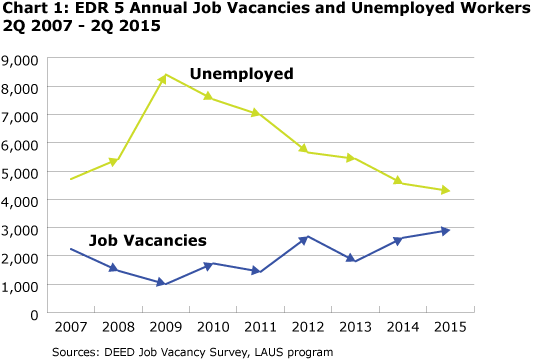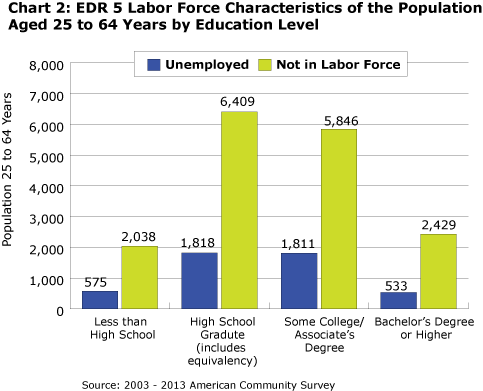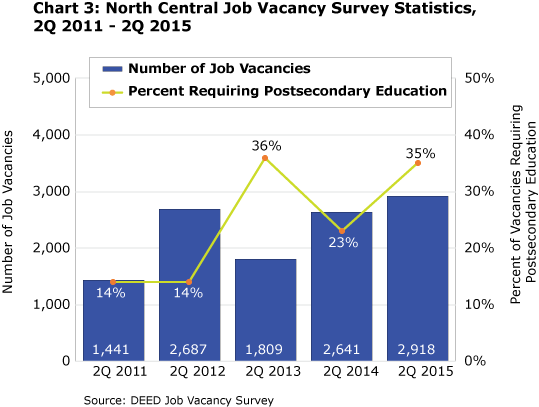by Chet Bodin
October 2015
Growth in job vacancies is considered a good sign of economic recovery. It suggests that companies are producing more or doing more business and need more workers to meet demand, which means job seekers should find it easier to get a job. Sometimes, however, the education or skill level of the workforce can be out of sync with what local employers are looking for, or the available employment opportunities do not satisfy job seekers. More often it's a little of both.
This looks to be the case in Economic Development Region 5 (EDR 5), which is made up of Cass, Crow Wing, Morrison, Todd, and Wadena counties in North Central Minnesota. Regional unemployment continues to fall as job vacancies rise, as has been the case during most of the recovery period following the Great Recession from 2007 to 2009 (see Chart 1).

Job Vacancy Survey results from the second quarter of 2015 shows 2,918 vacancies - the highest number of vacancies on record in the region, compared to 4,291 unemployed workers that were actively seeking work. While the region still has nearly 1,400 more unemployed workers than job vacancies, these trends could lead to a potential labor shortage in the future, where regional employers may find it even more difficult to fill positions.
Still, with more job seekers than vacancies in the most recent quarter, the data initially suggest that employers should be able to fill their openings comfortably. Unfortunately, employers report that this isn't always the case, and determining why hiring difficulties persist is an inexact science that is often more complicated than it appears. This article will examine possible reasons for lingering unemployment and hiring difficulties during economic growth, the changing education and skill requirements of regional vacancies, and how well they align with the supply of area job seekers in North Central.
The educational attainment of a community is often a major factor in how well its economy performs. A well-educated workforce can spur innovation, increase production, and promote growth. According to data from the U.S. Census Bureau's American Community Survey (ACS), nearly two-thirds (63.3%) of the workforce aged 25 to 64 years in North Central had at least some college experience, including 20 percent that had a Bachelor's degree or higher (see Table 1).
| Table 1: EDR 5 Educational Attainment, Population Aged 25 to 64 Years, 2009-2013 | ||||
|---|---|---|---|---|
| Education Level | Population, 25 to 64 years | In Labor Force | Percent of Labor Force | Unemployment Rate |
| Total Population, 25 to 64 years | 82,067 | 65,534 | 100.0% | 7.3% |
| Less than high school | 5,620 | 3,649 | 5.6% | 16.2% |
| High school graduate (includes equivalency) | 26,822 | 20,407 | 31.1% | 8.3% |
| Some college / Associate's degree | 34,102 | 28,384 | 43.3% | 6.9% |
| Bachelor's degree or higher | 15,523 | 13,094 | 20.0% | 4.1% |
| Source: American Community Survey, 5-year estimates 2009-2013 | ||||
Workers with a high school diploma or less made up the other one-third (36.7%) of the labor force in EDR 5, and they tended to have higher unemployment rates than workers with postsecondary education. Among the unemployed who are looking for work and those who may be available now or in the future but are not currently in the labor force, there are a lot more people in North Central with some college experience than employers might realize.
The number of unemployed workers with or without postsecondary education is nearly identical in EDR 5. According to ACS estimates, there were 2,393 unemployed people with a high school diploma or less in the region, and 2,344 unemployed people who had some college or a degree. Among the population who lived in the region but were not in the labor force, there were 8,447 people with a high school diploma or less, and 8,275 people with some college or a degree (see Chart 2).

This is encouraging news for employers in EDR 5 looking to add motivated personnel to their workforce. Unfortunately for job seekers with higher educational attainment, there appear to be fewer job vacancies in the region that require or value their level of postsecondary education. The underemployment of workers leaves unused potential in the labor market, while workforce shortages and a mismatch in skill demand creates other imbalances. Raising wage offers - and expectations - may draw more workers into the labor force and engage those looking for work in a way that more nearly match their qualifications.
Looking at data from DEED's Job Vacancy Survey, there appears to be some disparity between the job requirements for vacancies that employers are posting and the education levels of workers in the region. The results of the second quarter 2015 Job Vacancy Survey show that two-thirds of vacancies in EDR 5 require a high school diploma or less (see Table 2). As a result, the median wage offer of $10.24 for these job openings was relatively low, especially when compared to the state, which had a median wage offer of $12.99.
| Table 2: EDR Job Vacancy Statistics, Second Quarter 2015 | |||||||
|---|---|---|---|---|---|---|---|
| Number of Job Vacancies | Median Wage Offer | Percent of Job Vacancies Requiring: | |||||
| Less than High School | High School or Equivalent | Vocational Education | Associate's Degree | Bachelor's Degree | Advanced Degree | ||
| 2,918 | $10.24 | 38% | 28% | 13% | 9% | 11% | 2% |
| Source: DEED Job Vacancy Survey, 2Q 2015 | |||||||
Only 35 percent of job vacancies in EDR 5 required postsecondary education in 2015, which may seem low, but that number has remained relatively consistent the past few years. Considering that about 30 percent of North Central residents between the ages of 25 and 64 years have attained a postsecondary degree, this might appear to be a good match with the local workforce.
However, that counts only people who have received an Associate's, Bachelor's, or higher degree. When people with some college but no degree are factored in, the balance shifts considerably. As noted above, nearly two-thirds of EDR 5's 25 to 64 year old labor force participants have some college experience, while the other 36.7 percent have a high school diploma or less, leading to a mismatch for about 30 percent of workers who may be over-educated for the jobs available.
When the educational attainment of a labor force doesn't align well with regional employer needs, skilled workers can be compelled to look elsewhere to utilize what they've learned. On the other hand, employers who focus primarily on specialized education requirements may disqualify candidates who have demonstrated enthusiasm the aptitude to learn new skills on the job. Employers in North Central need to find the right balance between these two requirements.
Employers need to understand their local workforce to compete with other regions that could attract their local graduates. EDR 5 has a higher percentage of workers with lower educational attainment than statewide, especially those with a high school diploma or equivalent and some college or an Associate's degree, but a lower percentage of workers with bachelor's and advanced degrees. This indicates that job seekers in the region are more likely to have vocational training or work experience alone, which could be a good match for local employers.
Recent Job Vacancy Survey data show how regional employers have been adjusting in the past and what they can do in the future to find more workers ready to expand on their education and experience. As North Central's economy has recovered and employers have increased their job vacancies, postsecondary requirements have been increasing as well (see Chart 3).

The major hiring industries in North Central Minnesota are varied in their types of employment and occupational requirements, so a closer look at how postsecondary requirements have changed over time shows how different industries are reacting to regional workforce availability.
Healthcare and Social Assistance, Retail Trade, Educational Services, Manufacturing, Accommodation and Food Services, and Professional and Technical Services account for two-thirds (66.9%) of total employment in North Central, and typically post over two-thirds of the vacancies in the region. Combined, these industries were responsible for 80 percent of the job vacancies in the second quarter of 2015, but they reported very different education and experience requirements (see Table 3).
| Table 3: North Central Job Vacancy Survey Statistics by Industry Second Quarter 2015 | |||||||
|---|---|---|---|---|---|---|---|
| - | Number of Regional Jobs, 1Q 2015 | Number of Job Vacancies, 2Q 2015 | Percent Requiring High School or Less | Percent Requiring Some College or Associate's | Percent Requiring Bachelor's or Higher Degree | Percent Requiring 1 or More Years of Experience | Percent Part-Time |
| Total, All Industries | 57,668 | 2,918 | 66% | 22% | 13% | 24% | 47% |
| Health Care and Social Assistance | 10,721 | 478 | 49% | 41% | 10% | 15% | 66% |
| Retail Trade | 7,865 | 484 | 86% | 6% | 7% | 14% | 84% |
| Educational Services | 6,231 | 236 | 12% | 22% | 66% | 40% | 33% |
| Manufacturing | 6,189 | 199 | 90% | 8% | 3% | 23% | 0% |
| Accommodation and Food Services | 5,880 | 656 | 95% | 3% | 1% | 10% | 62% |
| Professional and Technical Services | 1,682 | 294 | 27% | 50% | 22% | 49% | 0% |
| Source: DEED Job Vacancy Survey 2Q 2015, Quarterly Census of Employment and Wages 1Q 2015 | |||||||
Just over half (51.4%) of the vacancies in these six industries were part-time, including two-thirds or more of the job openings in Retail Trade, Accommodation and Food Services, and Health Care and Social Assistance, which may also be contributing to lingering unemployment and underemployment in the region. This preponderance of part-time vacancies may present challenges to workers who prefer full-time employment.
On average over the past five years, less than 10 percent of vacancies in Retail Trade and Accommodation and Food Services and only about one-third of the vacancies in Manufacturing have required postsecondary education. This shows it may be less advantageous for employers in these industries to make workforce adjustments because of the nature of the work involved.
In contrast, more than half of the vacancies in Health Care and Social Assistance and two-thirds of the openings in Educational Services have been looking for college educated workers over the past five years, while the percentage of jobs requiring postsecondary education was increasing fastest in Professional and Technical Services (see Chart 4).
|
|
Despite changing skill requirements, Manufacturers appear to be consistently willing to hire workers with a high school diploma or less. In contrast, firms in the Professional and Technical Services industry appear to have made a concerted effort to hire more workers with postsecondary education over the past five years, especially those with some college or Associate's degrees. Similarly, the Healthcare and Social Assistance and Educational Services industries have reported an increase in the percentage of vacancies that require some college or an Associate's degree, perhaps in place of requiring more work experience. Overall, Educational Services had the most consistent demand for workers with a Bachelor's degree or higher.
Employers in North Central reported a record number of job vacancies, which should be a great environment for job seekers. However, the number of unemployed and available job seekers has been shrinking, and it can be a challenge to match their skills and experience to available jobs when the openings are highly compartmentalized by educational attainment.
In some industries, such as Retail Trade, Accommodation and Food Services, and Manufacturing, workers can get a job with a high school diploma or less. In other industries, such as Health Care, Educational Services, and Professional and Technical Services, workers with postsecondary education are in higher demand. This is important to know, given the number of job seekers with these qualifications. When seeking out talent, employers need to understand what job seekers are qualified for and look for in an occupation in addition to wages. They cannot afford to be bound by educational guidelines.
Regardless of their background, today's job seekers are looking for organizations and positions that allow them to learn, utilize their training, and grow professionally. Job seekers in North Central possess both experience and education that can benefit an employer depending on the area of need.